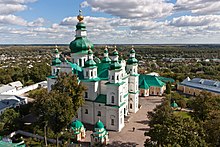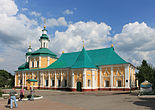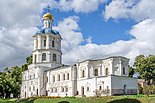Chernihiv
| Chernihiv | ||
| Чернігів | ||

|
|
|
| Basic data | ||
|---|---|---|
| Oblast : | Chernihiv Oblast | |
| Rajon : | District-free city | |
| Height : | no information | |
| Area : | 79.0 km² | |
| Residents : | 299,609 (January 1, 2006) | |
| Population density : | 3,793 inhabitants per km² | |
| Postcodes : | 14000 | |
| Area code : | +380 462 | |
| Geographic location : | 51 ° 30 ′ N , 31 ° 18 ′ E | |
| KOATUU : | 7410100000 | |
| Administrative structure : | 2 city rajons | |
| Mayor : | Wladyslav Atroschenko | |
| Address: | вул. Магістратська 7 14000 м. Чернігів |
|
| Website : | http://www.chernigiv-rada.gov.ua/ | |
| Statistical information | ||
|
|
||
Tschernihiw ( Ukrainian Чернігів ; Russian Чернигов Tschernigow ; Polish Czernihów ) is a city on the banks of the Desna in Ukraine and the capital of Chernihiv Oblast and the Chernihiv district with about 300,000 inhabitants (2006). The city is an important location of the Ukrainian Army through the Operative Army Command North located here .

Memorial in Chernihiv, in the background the Trinity Monastery
|
Administrative division
Administratively, the municipality is divided into the two Stadtrajone
- Desna with the districts Dytynez (Дитинець) Tretjak (Третяк) Peredhoroddja (Передгороддя) Okolnyj hrad (Окольний град) Bobrovytsia (Бобровиця) Pjat Kutiw ploschtscha (П'ять Кутів площа) and Jaliwschtschyna (Ялівщина)
- Nowosawod with the districts Tretjak (Третяк) Tschortoryjiwskyj Jary (Чорториївські Яри) Schawynka (Жавинка) Sabariwka (Забарівка) Sachidne (Західне) Koty (Коти) Liskowyzja (Лісковиця) Massany (Масани) Podussiwka Nova (Подусівка Нова) and Podussiwka Stara (Подусівка Стара)
history
Tschernihiw (former names: Tschernigow or Tschernigau ) is one of the oldest and most important cities of the Kievan Rus . It was the center of the East Slavic tribe of Severjan . When it was first mentioned in 907 , the city was named after Kiev in a list . From the 11th to the 13th century, Chernihiv was the capital of the Principality of Chernigov , which was sacked by the Mongols in 1239 . Traces of that time can be found in the black grave . From 1370 the city belonged to the Grand Duchy of Lithuania , from 1503 to the Grand Duchy of Moscow .
In 1611, Chernihiv was almost completely destroyed by Polish troops and in 1618 it went to the Polish-Lithuanian state association . In 1623 it got city rights according to Magdeburg law . In 1635 the Czernihów Voivodeship was formed. By the Khmelnyzkyj uprising of 1648 the city came under the control of the Zaporozhian Cossacks , who in 1654 submitted to the Russian tsar in the Treaty of Perejaslav . In 1667, membership of Russia was officially sealed in the Treaty of Andrussowo .
In 1781 there were 705 town houses, 4 brick factories, 12 churches and 4 monasteries in the city. In 1786 3 monasteries were closed. In 1802 the city became the capital of the Chernigov governorate . In 1895, gas lighting was replaced by electric lanterns on the main streets of the city, which still consisted mostly of wooden houses. The first all-Russian census in 1897 revealed 17,716 inhabitants for the city. At the beginning of the 20th century in Chernihiv a. a. several banks, 15 hotels and restaurants, 2 hospitals, a post office, a telegraph office and various technical and advanced training schools. In 1900 there were 428 shops, in 1910 there were already 734.
With the February Revolution of 1917 an increasing Ukrainization began in the city's media and administration. On February 1, 1918, Soviet power took control of Chernihiv. On March 12, 1918, German and Austrian troops were already in the city. On January 12, 1919, the city was retaken by the Red Army .
In 1925 the governorate was dissolved and replaced by a district administration. In 1926, 57% of the 35,200 inhabitants were Ukrainians, 20% Russians and 10% Jews. Chernihiv has been the capital of Chernihiv Oblast since 1932 .
During the Second World War , the German Wehrmacht took the city after almost two weeks of fighting on September 9, 1941. The Red Army recaptured the city on September 21, 1943 as part of their Chernigov-Poltava operation . Later the POW camp 177 (Tschernigow) existed in the city for German prisoners of war .
Attractions
Numerous buildings from the old Russian era have been preserved:
- The Transfiguration Cathedral ( Spasso-Preobrazhensky sobor , around 1036), the first cathedral of the Kievan Rus
- Boris and Gleb Cathedral ( Borissoglebski sobor , 12th century)
- Dormition Cathedral ( Uspenski sobor , mid-12th century) in the Jeletsky monastery
- Pyatnitsa Church ( Pyatnitskaya Tserkov , second half of the 12th century)
- Elias Church ( Illinskaya Zerkow , 12th century)
There are also several buildings from the 17th to 18th centuries ( Ukrainian Baroque ) and the 19th century ( Classicism ), including:
- Trinity Monastery (second half of the 17th century)
- College (1702)
- Katharinenkirche (1715)
The city is home to numerous monuments to historical figures, including Ivan Masepa , Bohdan Khmelnitsky and Taras Shevchenko .
coat of arms
Description: In the silver field a one-headed black, gold-crowned, red-tongued and so-eyed and gold-armored eagle , holding a large golden cross lying diagonally above him in the left claw .
The princes, descended from the holy Grand Duke Michael von Tschernigow , wielded the Tschernigow eagle.
Population development
Development of the population
- 1897: 27.716
- 1913: 35.850
- 1926: 35,200
- 1934: 68,600
- 1939: 69,000
- 2004: 302.097
- 2005: 300.497
- 2006: 299,609
Infrastructure
Air traffic
In the 1980s, the airport was moved out of the city to Schestovytsia. With the end of the Soviet Union, the airport lost its importance as a military flight school. There is no longer any significant air traffic today.
railroad
The Chernihiv station was created as a regional hub of the Russian Southwest Railways with connections to Nischyn (connection to the Moscow-Kiev route), Gomel and Ovrutsch. The first rail connection was made in 1981 from Nischyn with an 81 km (76 werst ) long narrow-gauge railway. After changing the gauge and extending the line to Gomel, the station was given its current location in 1928. The station building was built in 1950 by German and Hungarian prisoners of war according to plans by I. Granatkin. The station and routes are now part of the regional company Piwdenno-Sachidna Salisnyzja of the Ukrainian Railway . Since the Chernobyl accident, the line to Ovrutsch has only been operated as far as Janow on the Belarusian border. In 2006, 84,737 freight wagons and 4.5 million passengers were handled.
port
Chernihiv has an inland port on the Desna . In 2006, 356,200 tons of freight were handled and 22,100 passengers were carried.
Local public transport
The main load of local traffic is carried by the trolleybus network, which opened in 1964, with 9 lines and 46 bus lines. The trolleybus network (2012) is 53 km long (104.6 km of contact wire).
Twin cities
Chernihiv maintains partnerships with the following cities:
- Gabrovo , Bulgaria
- Gomel , Belarus
- Hradec Králové , Czech Republic
- Memmingen , Germany
- Petach Tikwa , Israel
- Prilep , North Macedonia
- Ogre , Latvia
- Tarnobrzeg , Poland
sons and daughters of the town
Others
Since June 2004 the ship Chernihiv of the Ukrainian Navy has been named after the city.
gallery
literature
- Sergej Udowik: Ukraine. Historic places . Wakler-Verlag Kiev 2010, ISBN 978-966-543-102-2 ; Pp. 6-12
Web links
- Czernihów . In: Filip Sulimierski, Władysław Walewski (eds.): Słownik geograficzny Królestwa Polskiego i innych krajów słowiańskich . tape 1 : Aa-Dereneczna . Sulimierskiego and Walewskiego, Warsaw 1880, p. 826 (Polish, edu.pl ).
Individual evidence
- ↑ Maschke, Erich (ed.): On the history of the German prisoners of war of the Second World War. Verlag Ernst and Werner Gieseking, Bielefeld 1962–1977.
- ^ Wilhelm Rein and Compagnie, Genealogical-chronological history of the most illustrious house of Romanow and its ancestral home , Balthasar Campenhausen, Leipzig 1805.
- ↑ Sister cities on chernigiv-rada.gov.ua (Ukrainian)















